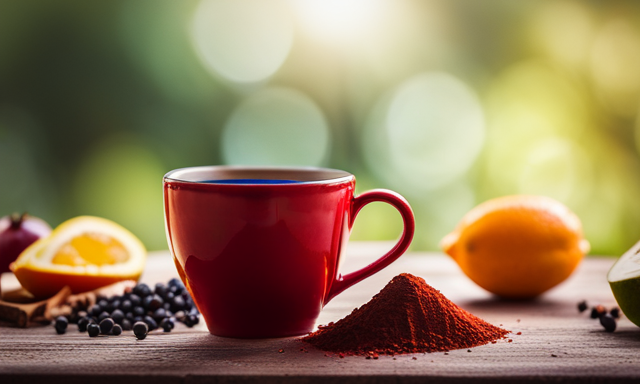Imagine sipping a warm, soothing cup of tea, the aromatic flavors swirling around your taste buds, calming your senses. Now, picture yourself growing that very tea in your own backyard.
Yes, you heard that right – you can cultivate your own rooibos tea and experience the joy of nurturing nature’s gift. As an avid tea lover and gardener, I have delved into the world of rooibos tea cultivation, and I am here to guide you on this delightful journey.
In this article, we will explore the origins and history of rooibos tea, as well as the essential steps to successfully grow and harvest your own tea leaves. From selecting the right seeds or seedlings to providing the ideal growing conditions, I will share my knowledge and tips to help you cultivate the finest rooibos tea.
So, let’s embark on this aromatic adventure together and unlock the secrets of growing rooibos tea.
Key Takeaways
- Regular pruning and maintenance are crucial for healthy rooibos plants, preventing disease and promoting new growth.
- Harvest rooibos tea leaves in summer when they are vibrant and rich in flavor, picking a few leaves from each branch to allow the plant to regenerate.
- Properly drying the leaves using methods such as air drying, sun drying, or using a dehydrator is important to prevent mold or mildew growth.
- Homemade rooibos tea can be brewed by steeping the leaves in boiling water for 5-7 minutes, and adding ingredients like lemon, honey, or cinnamon can create different flavors.
Introduction to Rooibos Tea
If you’re a tea lover, you’re in for a treat with rooibos tea and its unique flavor! Rooibos tea, also known as red bush tea, is a caffeine-free herbal tea that comes from the leaves of the Aspalathus linearis plant, native to South Africa.
This tea has gained popularity worldwide due to its numerous health benefits and delicious taste. Rooibos tea is rich in antioxidants, which can help boost your immune system and protect against diseases. It also contains several minerals like calcium, magnesium, and potassium, which are essential for maintaining good health.
Brewing techniques for rooibos tea are quite simple. It is best brewed with boiling water and should be steeped for about 5-7 minutes. After that, you can enjoy its aromatic and slightly sweet taste.
Moving on to the origin and history of rooibos tea, let’s delve into its fascinating story.
The Origin and History of Rooibos Tea
Originating from South Africa, rooibos tea has a rich history that dates back centuries. The indigenous people of the region, the Khoisan, were the first to discover the unique properties of the rooibos plant. They used it for its medicinal benefits and cultural significance in ceremonies. Today, rooibos tea is enjoyed worldwide for its delicious taste and numerous health benefits.
To better understand the origin and cultural significance of rooibos tea, let’s take a look at the following table:
| Origin | Cultural Significance | Medicinal Uses |
|---|---|---|
| South Africa | Ceremonial drink | Digestive aid |
| Allergy relief | ||
| Skin conditions |
Rooibos tea is known to boost the immune system, improve digestion, and alleviate allergies. Additionally, it is commonly used to treat skin conditions like eczema and acne.
Now, let’s transition to the next section and explore the process of selecting the right seeds or seedlings for growing rooibos tea.
Selecting the Right Seeds or Seedlings
When it comes to cultivating your own rooibos oasis, you’ll want to make sure you snag the perfect seeds or seedlings to embark on your tea-growing journey. Seed selection is crucial in ensuring a successful rooibos harvest. Look for seeds that are fresh, plump, and dark brown in color. Avoid seeds that are shriveled or discolored, as they may not germinate properly.
Consider purchasing seedlings instead, as they’re already established and have a higher chance of survival. Seedling care is equally important in the early stages of growth. Provide them with well-draining soil, ample sunlight, and regular watering to foster healthy root development.
Remember, the quality of your seeds or seedlings will greatly impact the overall success of your rooibos tea garden. Now, let’s dive into providing the ideal growing conditions for your precious plants.
Providing the Ideal Growing Conditions
In order to provide the ideal growing conditions for rooibos tea, it’s important to consider the soil and sunlight requirements. Rooibos tea thrives in well-draining soil with a pH level between 4.5 and 6.5. Additionally, it requires full sunlight for at least six hours a day.
Watering and fertilizing are also crucial aspects to consider when growing rooibos tea. It’s important to water the plants consistently, but not excessively, as overwatering can lead to root rot. Fertilizing should be done sparingly, using organic options such as compost or well-rotted manure, as rooibos tea is sensitive to chemical fertilizers.
Lastly, pest and disease control is essential in maintaining a healthy rooibos tea crop. Regularly inspecting the plants for pests, such as aphids or spider mites, and promptly addressing any issues can help prevent infestations. Additionally, practicing good sanitation and proper plant spacing can minimize the risk of diseases such as root rot or powdery mildew.
Soil and Sunlight Requirements
To successfully grow rooibos tea, you’ll need to ensure that your soil is well-draining and your plants receive plenty of sunlight. Here are three important factors to consider when it comes to soil and sunlight requirements:
-
Soil Preparation: Rooibos tea plants thrive in well-draining soil with a pH level between 6 and 7. It’s best to amend the soil with organic matter, such as compost or peat moss, to improve its texture and drainage. This will help prevent waterlogged roots and ensure optimal growth.
-
Sunlight Exposure: Rooibos tea plants require full sun to thrive. They need at least six hours of direct sunlight each day to produce high-quality leaves. Choose a location in your garden or yard that receives abundant sunlight throughout the day.
-
Transition to Watering and Fertilizing: Once you’ve prepared the soil and ensured adequate sunlight exposure, the next step is to focus on watering and fertilizing your rooibos tea plants.
Watering and Fertilizing
Make sure you’re watering and fertilizing your plants regularly, as they rely on these essential nutrients for healthy growth and optimal leaf production. Did you know that proper watering and fertilizing can increase the yield of tea leaves by up to 30%?
When it comes to watering techniques, it’s important to strike a balance. Rooibos plants thrive in well-drained soil, so be careful not to overwater them. Aim to keep the soil consistently moist, but not waterlogged.
As for fertilization, rooibos plants benefit from a nitrogen-rich fertilizer. Apply it every four to six weeks during the growing season to ensure that your plants receive the necessary nutrients for robust growth.
With proper watering and fertilization, you’ll set the stage for healthy rooibos plants. Now let’s talk about pest and disease control.
Pest and Disease Control
Pest and disease control is crucial for maintaining the health and vitality of your thriving rooibos plants. Integrated pest management is an effective approach that combines various strategies to prevent and control pests and diseases in an environmentally-friendly manner. Regular monitoring of your plants is essential to detect any signs of infestation or disease early on.
Some common diseases in rooibos tea cultivation include powdery mildew, root rot, and leaf spot. Proper sanitation and hygiene practices, such as removing infected plant material and cleaning tools, can help prevent the spread of diseases. Additionally, using organic fertilizers and promoting a balanced ecosystem in your garden can enhance the natural resistance of your rooibos plants to pests and diseases.
Now, let’s move on to the next section about planting and transplanting rooibos tea.
Planting and Transplanting Rooibos Tea
Unfortunately, if you’re looking for a quick and easy way to grow rooibos tea, I’m afraid you’re out of luck. Planting and transplanting rooibos tea requires careful attention to detail and adherence to specific planting techniques.
It is important to choose an appropriate location that provides the ideal growing conditions for rooibos tea, such as well-draining soil with a pH level between 4.5 and 6.5. The plants prefer full sun exposure and thrive in warm climates.
When planting, ensure that the root ball is placed at the same depth as it was in the original container and gently firm the soil around it. Water thoroughly after planting and maintain regular watering throughout the growing season.
Pruning and maintaining rooibos tea plants is essential for their health and productivity, but we’ll delve into that in the next section.
Pruning and Maintaining Rooibos Tea Plants
To keep your rooibos plants healthy and thriving, regular pruning and maintenance is crucial. Here are three important pruning techniques to help you maintain plant health:
-
Deadheading: Remove any dead flowers or buds to encourage new growth and prevent disease.
-
Thinning: Thin out overcrowded branches to improve air circulation and light penetration, which can prevent fungal infections.
-
Shaping: Prune the plant to maintain a desired shape and size. Trim back long, leggy branches to promote bushier growth.
Proper pruning not only keeps your rooibos plants looking neat and tidy but also helps prevent pest infestation and diseases. By maintaining the health of your plants through regular pruning, you ensure a bountiful harvest of rooibos tea leaves.
In the next section, we’ll discuss the important steps for harvesting and drying these leaves.
Harvesting and Drying Rooibos Tea Leaves
When it’s time to harvest and dry your rooibos tea leaves, you’ll want to explore the process to see if the theory of improving flavor through proper drying holds true for you.
Harvesting techniques play a crucial role in obtaining high-quality leaves. The best time to harvest is in the summer months when the leaves are vibrant and rich in flavor. To ensure the health of the plant, it’s important to only pick a few leaves from each branch, allowing the plant to regenerate.
Once harvested, the leaves need to be dried properly to prevent the growth of mold or mildew. Common drying methods include air drying, sun drying, or using a dehydrator. Each method has its own advantages, so choose the one that suits your preferences and climate.
After the leaves are dried, you can move on to the exciting process of preparing and brewing your homemade rooibos tea, where the true flavors will shine.
Preparing and Brewing Homemade Rooibos Tea
Get ready to experience the rich flavors of your homemade rooibos tea as you carefully prepare and brew it, allowing the aromas to envelop your senses. Homemade rooibos tea offers a range of benefits, including its high antioxidant content and potential to aid digestion.
When preparing your tea, you can choose from various flavors by adding ingredients like lemon, honey, or cinnamon. Experimenting with different flavors will help you find the perfect blend that suits your taste buds.
To brew your tea, simply add boiling water to a teapot or cup with the rooibos tea leaves and let it steep for 5-7 minutes. The longer you steep, the stronger the flavor.
Now that you’ve brewed your homemade rooibos tea, it’s time to learn how to store and enjoy it for maximum freshness and flavor.
Storing and Enjoying Your Homemade Rooibos Tea
Contrary to popular belief, storing and enjoying your homemade rooibos tea isn’t as complicated as it may seem. To ensure the freshness and flavor of your tea, it’s important to store it properly. The best method is to keep it in an airtight container away from sunlight, moisture, and strong odors. This will prevent the tea from absorbing unwanted flavors and losing its aroma.
Additionally, storing rooibos tea in a cool, dry place will prolong its shelf life. Not only is rooibos tea delicious, but it also offers numerous health benefits. Packed with antioxidants, it can boost your immune system, aid digestion, and promote relaxation.
Now that you know how to store and enjoy your homemade rooibos tea, let’s move on to some tips and tricks for successful rooibos tea cultivation.
Tips and Tricks for Successful Rooibos Tea Cultivation
Now that you’ve learned how to store and enjoy your homemade Rooibos tea, let’s explore some tips and tricks for successfully cultivating this delightful beverage. Cultivating Rooibos tea requires careful attention to detail and proper techniques to ensure a bountiful harvest. Here are some key points to keep in mind:
- Choose the right location: Rooibos plants thrive in well-drained soil and prefer a sunny spot in your garden.
- Provide ample water: Rooibos plants require regular watering, especially during dry spells.
- Prune regularly: Regular pruning helps promote new growth and improves the overall health of the plants.
- Use organic fertilizers: Avoid chemical fertilizers and opt for organic alternatives to maintain the integrity and flavor of your tea leaves.
- Harvest at the right time: Harvest the leaves when they’re young and vibrant for the best tea production.
By following these tips, you can ensure successful Rooibos tea cultivation and enjoy the fruits of your labor in the form of delicious, homemade tea.
Frequently Asked Questions
Can rooibos tea be grown in containers or pots?
Yes, rooibos tea can be grown in containers or pots. Growing rooibos tea in containers has several benefits, such as easier maintenance and the ability to control the growing conditions indoors.
How long does it take for rooibos tea plants to mature and produce leaves?
Rooibos tea plants mature and start producing leaves in about 18-24 months. With proper rooibos tea plant care, you can celebrate your first harvest and delight in the flavors of your homegrown tea.
What are the common diseases or pests that affect rooibos tea plants and how can they be managed?
Managing diseases and pests in rooibos tea plants is crucial for a successful harvest. Common issues include spider mites, aphids, and fungal diseases. Regular monitoring, proper sanitation, and organic pest control methods are effective in preventing and managing these problems. Harvesting and drying rooibos tea leaves should be done carefully to ensure the best flavor and quality.
Is it possible to grow rooibos tea in a cold climate?
Growing rooibos tea in a cold climate is challenging, but not impossible. By cultivating it in a greenhouse or indoors, we can create a controlled environment that mimics its native habitat and ensures optimal growth conditions.
Can I use the leaves from my rooibos tea plant immediately after harvesting, or do they need to be dried first?
You can use freshly harvested rooibos leaves for tea without drying them, but air drying the leaves has its benefits. Drying helps to enhance the flavor and aroma, and it also extends the shelf life of the tea.
Conclusion
In conclusion, growing your own rooibos tea is an absolute game-changer. The pleasure of sipping on a cup of homemade rooibos tea, knowing that you nurtured and cultivated it yourself, is simply unparalleled.
The process may seem daunting at first, but with the right knowledge and a little bit of effort, you can create a tea that will leave you and your taste buds in sheer bliss. So go ahead, embrace your inner tea connoisseur and embark on this journey of rooibos tea cultivation. Trust me, the rewards are extraordinary.










